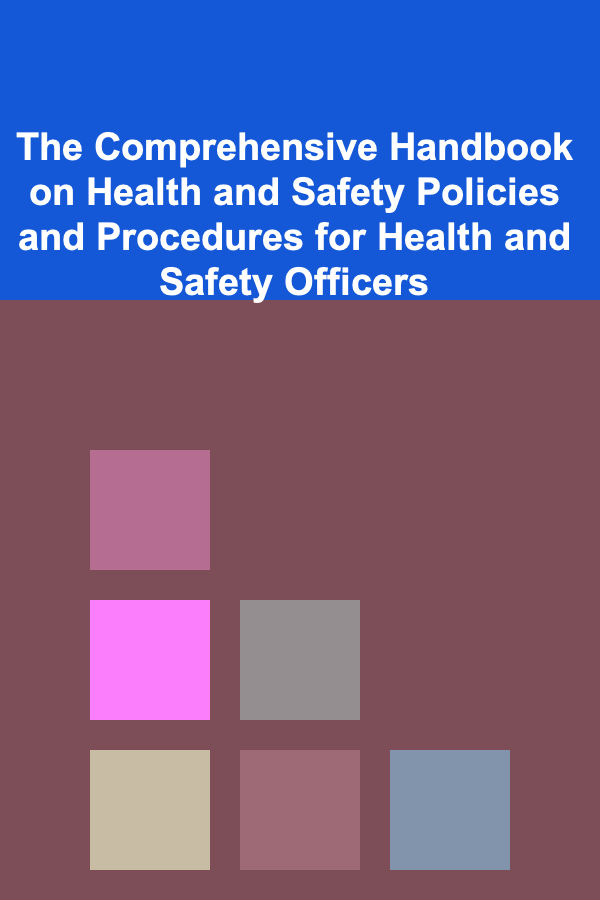
The Comprehensive Handbook on Health and Safety Policies and Procedures for Health and Safety Officers
ebook include PDF & Audio bundle (Micro Guide)
$12.99$5.99
Limited Time Offer! Order within the next:

Health and safety are fundamental pillars of a thriving workplace. Health and Safety Officers (HSOs) play a vital role in ensuring that organizations adhere to best practices, legal requirements, and ethical standards when it comes to the well-being of employees. In this comprehensive guide, we will explore actionable policies and procedures that Health and Safety Officers should implement to protect workers, mitigate risks, and foster a culture of safety.
Understanding the Role of Health and Safety Officers
The primary responsibility of a Health and Safety Officer is to create and maintain a work environment that minimizes risks and hazards. This involves:
- Identifying potential hazards.
- Implementing safety measures and controls.
- Educating employees on safety protocols.
- Ensuring compliance with local, national, and international health and safety laws.
Health and Safety Officers serve as advocates for worker safety and well-being while ensuring the company remains compliant with relevant regulations.
Key Health and Safety Policies
2.1 Risk Assessment Policy
A core part of a Health and Safety Officer's duties involves conducting risk assessments. A risk assessment policy outlines the framework for identifying potential hazards and evaluating the risks they pose.
Key Steps:
- Hazard Identification: Inspect the workplace regularly to spot any potential hazards, such as machinery, chemicals, and ergonomic risks.
- Risk Evaluation: Assess the likelihood and potential impact of each identified hazard.
- Control Measures: Develop measures to mitigate the risks, such as engineering controls, administrative controls, or personal protective equipment (PPE).
2.2 Emergency Response Policy
Emergencies can arise unexpectedly, and a solid emergency response policy is essential for ensuring that workers know how to react in the event of accidents, fires, or natural disasters.
Key Elements:
- Emergency Contact Information: Clearly display emergency contacts for first aid, fire departments, and relevant authorities.
- Evacuation Procedures: Create and regularly rehearse evacuation routes and emergency exits.
- First Aid and Medical Response: Designate first aid stations and train employees in basic first aid procedures.
- Fire Safety: Ensure fire extinguishers, alarms, and sprinkler systems are in place and maintained.
2.3 Personal Protective Equipment (PPE) Policy
The use of personal protective equipment is vital for safeguarding employees in high-risk environments. This policy ensures the correct selection, use, and maintenance of PPE.
Key Aspects:
- PPE Requirements: Outline the types of PPE required for various job functions, such as hard hats, gloves, masks, and safety boots.
- Training: Provide training on how to use, maintain, and dispose of PPE correctly.
- Inspection: Regularly inspect PPE for damage or wear and replace as necessary.
2.4 Workplace Safety Training Policy
Ongoing safety training is crucial to maintaining a safe working environment. This policy ensures that all employees understand the hazards they face and the proper safety measures to follow.
Key Points:
- Orientation for New Employees: Introduce safety protocols to new hires as part of their onboarding process.
- Refresher Courses: Offer periodic safety training sessions to keep employees up to date on best practices and regulatory changes.
- Specialized Training: Provide training for employees who handle dangerous materials, machinery, or work in high-risk areas.
Health and Safety Procedures
3.1 Hazard Reporting Procedure
Having a clear and accessible reporting system for hazards ensures that potential risks are addressed promptly. Employees should feel empowered to report hazards without fear of retaliation.
Steps to Implement:
- Reporting Channels: Establish clear channels for reporting, such as digital platforms, email, or physical forms.
- Confidentiality: Ensure employees' identities are protected when they report safety concerns.
- Action and Follow-Up: Health and Safety Officers should promptly investigate reported hazards and implement corrective actions.
3.2 Incident Reporting and Investigation Procedure
Reporting and investigating incidents, including near-misses, is crucial for improving safety measures and preventing future accidents.
Key Actions:
- Incident Report Forms: Create standardized forms to capture all relevant details of an incident (date, time, individuals involved, nature of the incident).
- Investigation Process: Health and Safety Officers should lead investigations to determine the root cause of incidents and recommend corrective actions.
- Corrective Actions: Develop a plan to rectify the hazard or issue identified during the investigation, and track its implementation.
3.3 Workplace Inspections Procedure
Regular workplace inspections are an essential part of identifying hazards before they lead to accidents.
Steps to Follow:
- Routine Inspections: Conduct routine inspections of the workplace to identify hazards, assess existing safety measures, and ensure that safety standards are being followed.
- Inspection Checklist: Create a comprehensive checklist covering different areas such as fire safety, machinery, PPE, and ergonomic conditions.
- Documentation and Reporting: Keep detailed records of each inspection, including findings, corrective actions, and timelines for implementation.
3.4 Safe Work Practices Procedure
Safe work practices outline the steps that employees must follow to ensure their safety while performing tasks.
Components:
- Standard Operating Procedures (SOPs): Develop and enforce SOPs for common tasks, ensuring that they are safe and efficient.
- Job Safety Analysis (JSA): For tasks with inherent risks, conduct a JSA to evaluate the potential hazards and create a safe method of execution.
- Supervision and Enforcement: Supervisors must ensure that employees adhere to safe work practices at all times.
Health and Safety Culture in the Workplace
4.1 Creating a Safety-First Culture
The most successful health and safety programs are those in which safety is a fundamental value of the organization. This "safety-first" mindset should be embedded in the company culture, ensuring that safety is prioritized at all levels of the organization.
Key Strategies:
- Leadership Commitment: Management should lead by example, actively participating in safety initiatives and demonstrating a commitment to employee well-being.
- Employee Involvement: Involve employees in safety committees, hazard identification, and policy development. When employees are engaged in the process, they are more likely to follow safety protocols.
- Positive Reinforcement: Recognize and reward employees who demonstrate a commitment to safety. Positive reinforcement encourages adherence to safety standards and behaviors.
4.2 Communication and Engagement
Effective communication is critical for fostering a culture of safety. Employees need to be continuously informed about safety policies, procedures, and any changes that might impact their work environment.
Methods:
- Regular Safety Meetings: Hold regular meetings to discuss safety concerns, share updates, and offer training.
- Safety Bulletins and Alerts: Use posters, emails, or intranet to disseminate important safety information, such as new policies, hazard alerts, or safety tips.
- Feedback Mechanisms: Implement a system where employees can provide feedback on safety initiatives, suggest improvements, and raise concerns.
Compliance with Health and Safety Regulations
Health and Safety Officers must ensure that the organization complies with all relevant health and safety regulations. These regulations may vary depending on the country, industry, and type of work being performed. Regularly reviewing and understanding local, national, and international safety standards is essential for maintaining compliance.
Key Points:
- Legal Requirements: Stay informed about health and safety laws and regulations that affect your organization. This includes OSHA (Occupational Safety and Health Administration) standards, fire safety laws, environmental regulations, and industry-specific safety guidelines.
- Audit and Inspections: Conduct internal audits and prepare for external regulatory inspections to ensure compliance.
- Record-Keeping: Keep accurate records of safety training, inspections, incidents, and corrective actions. These records are crucial in demonstrating compliance during audits or inspections.
Continuous Improvement of Health and Safety Policies
Health and safety policies should evolve with time, reflecting changes in regulations, technology, and best practices. Continuously improving policies and procedures ensures the ongoing protection of employees.
Methods for Continuous Improvement:
- Regular Policy Reviews: Schedule regular reviews of health and safety policies to incorporate any new regulations or emerging hazards.
- Post-Incident Analysis: After any safety incident, conduct a detailed review to identify lessons learned and apply improvements to policies and procedures.
- Benchmarking: Compare your organization's health and safety practices with industry leaders and adopt best practices where applicable.
Conclusion
Health and Safety Officers play an integral role in creating a safe and compliant workplace. By developing and implementing comprehensive health and safety policies and procedures, organizations can minimize risks, protect employees, and foster a positive safety culture. This handbook provides a roadmap for HSOs to effectively manage workplace health and safety, ensuring that both employees and organizations thrive in a secure environment. Through ongoing commitment, vigilance, and continuous improvement, organizations can build and maintain the highest standards of safety.

How to Design a Timeless Home Renovation
Read More
How to Maintain Your Pet's Health Through Proper Home Care
Read More
How to Make a Checklist for Running Effective Reference Checks
Read More
How to Organize Your Cooking Utensils for Meal Prep
Read More
How to Understand and Use Asset Allocation to Reduce Risk
Read More
How to Use Folding Tables for Temporary Tool Storage
Read MoreOther Products

How to Design a Timeless Home Renovation
Read More
How to Maintain Your Pet's Health Through Proper Home Care
Read More
How to Make a Checklist for Running Effective Reference Checks
Read More
How to Organize Your Cooking Utensils for Meal Prep
Read More
How to Understand and Use Asset Allocation to Reduce Risk
Read More